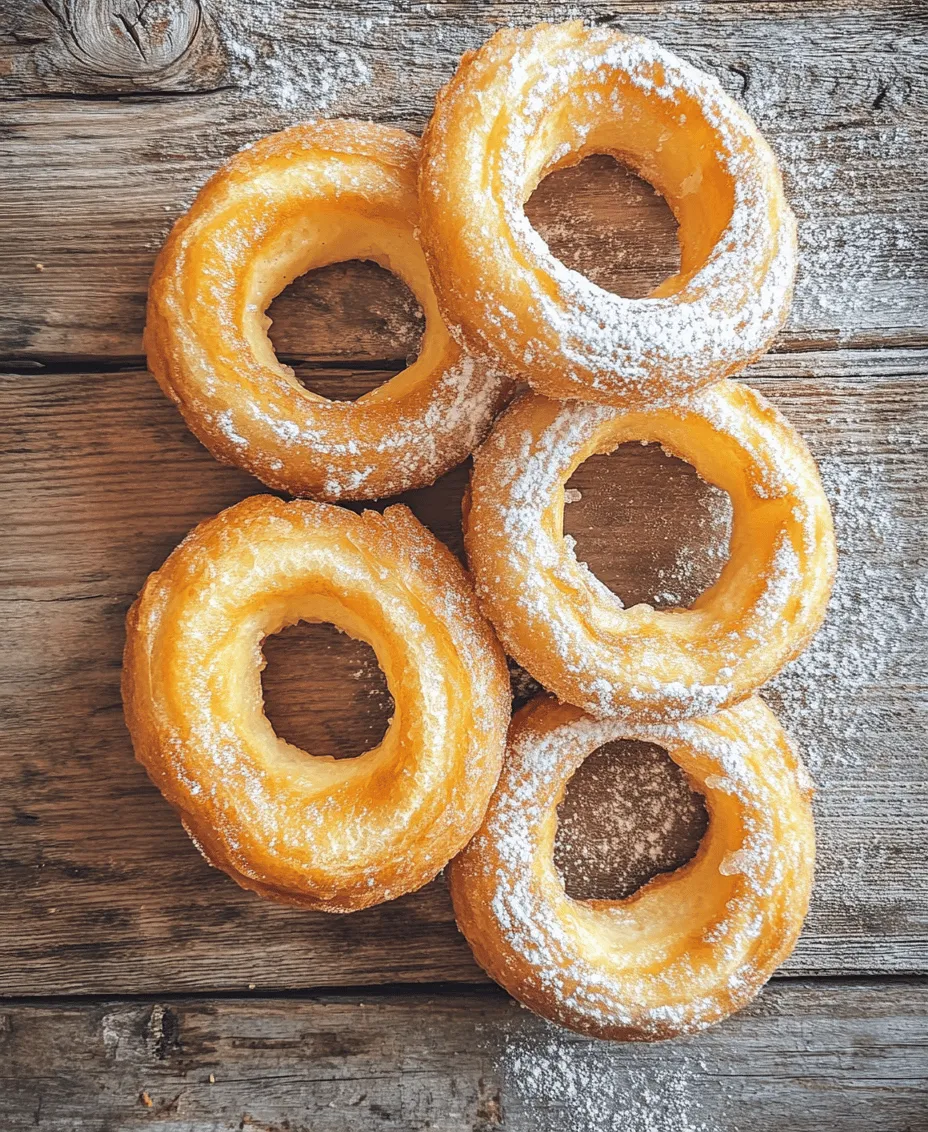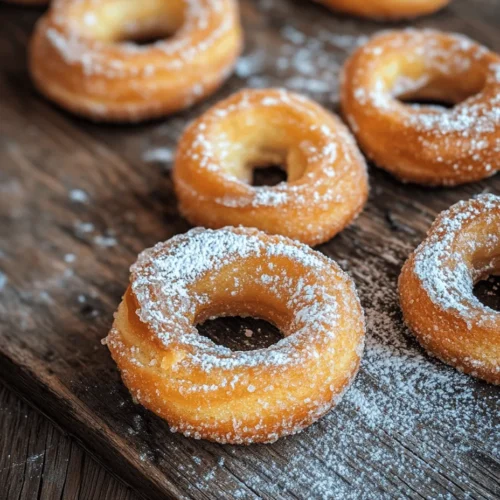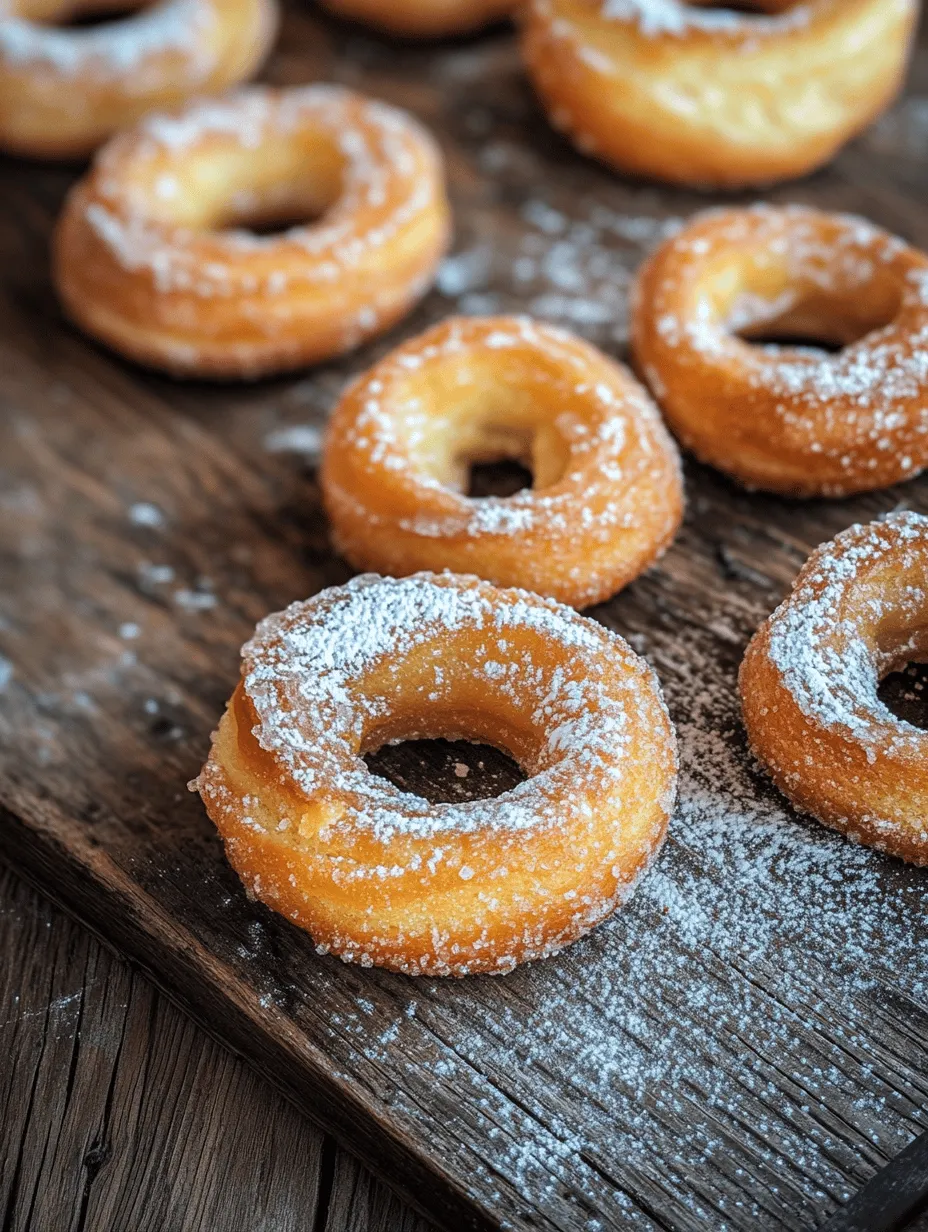Introduction
French crullers, with their distinctive shape and airy texture, have captivated pastry lovers for centuries. Originating from France, crullers are a delightful variation of the classic donut, known for their light, airy structure and rich flavor. Unlike traditional yeast donuts, crullers are made from choux pastry, which gives them a unique fluffy quality that melts in your mouth. This recipe aims to guide you through the art of making homemade French crullers, ensuring you achieve that perfect balance of fluffiness and flavor that can sometimes be elusive in store-bought varieties.
In this article, you will learn not only how to prepare these delightful treats but also the historical context behind crullers, their place in French pastry tradition, and the science that makes them so special. You’ll gain insights into each ingredient’s role in creating the perfect cruller and receive step-by-step instructions that will empower you to master this delicious pastry. Whether you’re a baking novice or a seasoned pro, this recipe is crafted to ensure success in your kitchen.
Understanding Crullers
Definition of Crullers
Crullers are a type of pastry that stands out in the world of French desserts. They are typically made from a dough known as pâte à choux, which is the same base used for cream puffs and éclairs. This dough is cooked on the stovetop before being piped into a twisted, ring-like shape, which is then deep-fried to achieve a golden-brown exterior. The result is a light and airy texture that contrasts beautifully with a sweet glaze or dusting of powdered sugar. Crullers are not only visually appealing but also offer a delightful bite that sets them apart from their more traditional cake or yeast donut counterparts.
Comparison with Other Types of Donuts and Pastries
What makes crullers unique is their method of preparation and texture. Traditional donuts are typically made from yeast or cake batters, which lend them a denser consistency. Yeast donuts require proofing time to allow the dough to rise, while cake donuts are made with baking powder, resulting in a heavier crumb. In contrast, crullers’ pâte à choux provides a lightness and airiness that is unmatched, giving them a stunningly fluffy bite.
Moreover, crullers are often distinguished by their unique shape. The twisted or knotted form allows for more surface area to absorb flavors from glazes and toppings, enhancing their overall taste experience. This distinctive design, combined with the lightness of the choux pastry, makes crullers a favorite among pastry enthusiasts.
Historical Context
The evolution of crullers can be traced back to several cultures, each contributing to the pastry’s rich history. The term “cruller” itself is believed to have Dutch origins, deriving from the word “krullen,” which means “to curl.” This reflects the pastry’s characteristic shape. In France, crullers have been embraced in patisseries for their delicate texture and flavor, becoming a staple in both homes and bakeries.
Historically, these pastries were often associated with celebrations and special occasions, enjoyed alongside coffee or tea. Their cultural significance is evident in their presence in various cuisines, with each region adding its twist to the cruller. As these delightful treats have spread globally, they continue to be cherished for their unique characteristics and are often seen as a symbol of indulgence and delight.
Ingredients Breakdown
Creating the perfect French cruller begins with understanding the role of each ingredient in your dough. Here’s a detailed breakdown of what you’ll need:
– Water: Water is crucial for achieving the right consistency in your dough. It provides the moisture needed to create steam during the cooking process, which helps the crullers puff up beautifully while frying. The correct ratio is essential, as too much water can lead to a soggy texture, while too little can result in a dry pastry.
– Unsalted Butter: Butter plays a significant role in the flavor and texture of crullers. By using unsalted butter, you can control the saltiness of the dough while enhancing its richness. The butter adds moisture and tenderness, ensuring that each bite is soft and flavorful.
– All-Purpose Flour: The backbone of your cruller dough, all-purpose flour, provides structure and stability. It contributes to the overall fluffiness of the pastry while allowing it to hold its shape during frying. Be sure to measure the flour correctly to avoid a heavy or dense texture.
– Salt: A small amount of salt is essential for enhancing the overall taste of your crullers. It balances the sweetness and brings out the flavors of the other ingredients, making every bite more enjoyable.
– Nutmeg (optional): Nutmeg is a warm spice that adds a subtle depth of flavor to your crullers. While it’s optional, its aromatic qualities can elevate the overall taste profile, making your pastry even more delightful.
– Eggs: Eggs are a key ingredient in choux pastry, providing richness and helping to bind the dough together. They contribute to the crullers’ light texture by creating steam during cooking, which causes the pastry to rise and become airy.
– Vanilla Extract: The addition of vanilla extract enhances the flavor of your crullers, providing a sweet and aromatic base that pairs beautifully with the other ingredients. It’s a simple touch that can make a significant difference in the overall taste.
– Vegetable Oil: For frying, vegetable oil is the best choice due to its high smoke point, which is important for achieving a crispy exterior without burning. When frying crullers, maintaining the right oil temperature is crucial for ensuring they cook evenly and achieve that golden-brown color.
– Powdered Sugar and Milk/Water: To create the perfect glaze for your crullers, powdered sugar combined with milk or water will give you a smooth, sweet topping that complements the airy texture of the pastry. Adjust the consistency to your preference, whether you want a thicker or thinner glaze.
Step-by-Step Instructions for Making French Crullers
Preparing the Dough: Key Techniques for Success
The first step in crafting your delightful French crullers begins with preparing the choux pastry dough. Follow these key techniques to ensure success:
1. Boil the Water and Butter: In a medium saucepan, combine water, unsalted butter, and salt. Heat over medium-high heat until the mixture comes to a rolling boil, and the butter is completely melted. This step is crucial, as it creates a base for your dough.
2. Incorporate the Flour: Once boiling, remove the saucepan from heat and add the all-purpose flour all at once. Stir vigorously with a wooden spoon until the mixture forms a cohesive ball and pulls away from the sides of the pan. This process helps to cook the flour, which is essential for the crullers’ structure.
3. Cook the Dough: Return the saucepan to low heat and continue stirring for about 1-2 minutes. This step is important to dry out the dough slightly, ensuring it will hold its shape during frying. You’ll know the dough is ready when it forms a smooth ball and has a slight sheen.
4. Cool the Dough: Transfer the dough to a mixing bowl and let it cool for a few minutes. This cooling step is essential before adding the eggs, as hot dough can cook the eggs and affect the consistency.
5. Incorporate the Eggs: Once the dough has cooled slightly, add the eggs one at a time, mixing thoroughly after each addition. The dough should become smooth and glossy, with a pipeable consistency. This step is crucial for achieving the light and airy texture that crullers are known for.
6. Piping the Crullers: Prepare a piping bag fitted with a star-shaped nozzle. Spoon the dough into the bag and pipe your crullers onto a parchment-lined baking sheet. Aim for a twisted shape, as this will give your crullers their distinctive look and allow for even frying.
Importance of Stirring and Cooking the Dough Properly
The key to successful crullers lies in the preparation of the choux pastry. Stirring the dough vigorously during the initial stages ensures that it is well combined and cooked through, which is essential for the pastry’s structure. The cooking process helps to eliminate excess moisture, allowing the dough to puff up beautifully when fried.
Additionally, the incorporation of eggs must be done gradually and carefully. Adding too many eggs at once can lead to a runny dough, while adding them too slowly can result in uneven texture. Achieving the right consistency is crucial for piping the crullers effectively and ensuring they maintain their shape during frying.
Tips on How to Know When the Dough is Ready
To determine if your choux pastry is ready for the eggs, look for these signs:
– The dough should form a smooth ball and not stick to the sides of the pan.
– It should have a glossy appearance and be slightly warm to the touch, but not hot.
– When piped, the dough should hold its shape without collapsing, indicating it has the right consistency for frying.
With these steps and insights, you are well on your way to creating delightful French crullers that will impress your family and friends. These pastries are not just a treat; they’re a labor of love that embodies the essence of French patisserie. Stay tuned for the continuation of this recipe, where we’ll delve into the frying process, glazing techniques, and tips for achieving the best results.

Incorporating Eggs: Techniques for Achieving Smooth Dough
The key to crafting delightfully fluffy French crullers begins with the perfect dough. Incorporating eggs into your batter is a critical step that contributes to the light, airy structure of these pastries. Begin by ensuring your eggs are at room temperature before adding them to your mixture. Cold eggs can lead to a lumpy batter, which may affect the texture of your crullers.
To achieve a smooth dough, follow these steps:
1. Whisking Technique: Start by whisking the eggs in a separate bowl until they are uniform in color. This process helps to break down the proteins, which allows for better incorporation into the dough.
2. Gradual Addition: Add the eggs to the warm mixture of butter, sugar, and milk gradually. This gradual incorporation is vital. Start with a small amount of egg mixture, stir well, and then continue adding until fully combined. This method promotes emulsification, ensuring that your dough is smooth and free of lumps.
3. Visual Cues: As you mix, look for the dough to become glossy and somewhat elastic. This indicates that the eggs have emulsified properly with the other ingredients.
Piping the Crullers: Tips for Perfect Shapes
Once your dough is ready, it’s time to shape your crullers. Piping is a crucial technique that requires precision to achieve that classic cruller form.
1. Choosing the Right Piping Tip: For traditional crullers, a star-shaped piping tip is recommended. This will create the characteristic ridges on the surface of the dough, which not only enhances visual appeal but also helps in trapping the glaze later.
2. Piping Technique: Fill a piping bag fitted with your chosen tip and hold it perpendicular to the surface. Gently squeeze and release to create rings, ensuring to pipe dough in a continuous motion. Aim for a diameter of about 2-3 inches, and create a second smaller circle on top of the first to form the cruller shape.
3. Achieving Uniformity: To ensure that all crullers are the same size, consider using a stencil or template. Simply cut out circles from parchment paper and place them underneath your piping bag. This will guide your piping and help achieve consistency in size and shape.
Frying the Crullers: Best Practices for Frying
Frying is where the magic happens, transforming your dough into the light, airy treats you crave. Maintaining the right frying conditions is essential for perfect crullers.
1. Temperature Control: The ideal frying temperature for crullers is between 350°F and 375°F (175°C to 190°C). Use a deep-fry thermometer to monitor the temperature of the oil closely. If the oil is too hot, the crullers will brown too quickly and remain raw on the inside. Conversely, oil that is not hot enough will result in greasy pastries.
2. Avoiding Soggy or Greasy Crullers: To prevent sogginess, maintain the temperature of the oil by frying in small batches. This will help the temperature of the oil remain consistent. Additionally, avoid overcrowding the frying pot, as this can lower the oil temperature significantly.
3. Frying Technique: Gently lower the piped crullers into the hot oil using a slotted spoon. Allow them to cook undisturbed for about 2-3 minutes on each side, or until they are golden brown. Flip them carefully with the spoon to ensure even cooking.
Making the Glaze: Creating the Perfect Finishing Touch
Once your crullers are perfectly fried, it’s time to add that signature glaze. A good glaze not only enhances the flavor but also adds a beautiful sheen to your crullers.
1. Adjusting Glaze Consistency: To create a simple glaze, whisk together powdered sugar and milk until smooth. The consistency should be thick enough to coat the back of a spoon but thin enough to drip off easily. If it’s too thick, add a splash of milk; if too thin, incorporate more powdered sugar.
2. Flavor Variations: Get creative with your glaze! Consider infusing it with vanilla extract, citrus zest, or even a splash of coffee or chocolate for a unique twist. For a more decadent option, melt chocolate and dip the crullers for a rich finish.
Serving and Storing French Crullers
Once your crullers are glazed and ready, serving them correctly enhances the experience.
1. Best Ways to Serve Crullers: French crullers are best enjoyed fresh, served at room temperature. Arrange them on a beautiful platter to showcase their delightful shapes and glazes.
2. Ideal Pairing Suggestions: Pair your crullers with freshly brewed coffee or tea for a classic combination. The rich flavors of the beverages complement the sweetness of the crullers beautifully.
3. Storing Leftover Crullers: If you have leftovers, store them in an airtight container at room temperature for up to two days. For longer storage, consider refrigerating them, but be aware this may affect their texture.
4. Reheating Tips: To restore their delightful texture, you can reheat the crullers in a preheated oven at 350°F (175°C) for about 5-7 minutes. This will help them regain their crispiness.
Nutritional Information and Dietary Considerations
Understanding the nutritional profile of your homemade French crullers can help you make informed decisions about your indulgences.
1. Overview of the Nutritional Profile: A typical French cruller contains around 130-150 calories, depending on size and glaze. They are primarily composed of carbohydrates and fats, with a small amount of protein from the eggs.
2. Suggestions for Healthier Modifications: If you’re looking to make a healthier version, consider experimenting with gluten-free flour options or reducing the sugar in the glaze. Using almond or coconut flour can add unique flavors and textures while making them gluten-free.
3. Considerations for Dietary Restrictions: Always be mindful of any dietary restrictions. For those avoiding eggs, you can try using flaxseed meal or applesauce as an egg substitute, though the texture may vary slightly.
Conclusion
There’s a special joy in making and enjoying homemade French crullers—from the initial mixing of ingredients to the final glazing touch. These airy delights are not only a treat for yourself but also a fantastic way to share joy with others. As you embark on this culinary adventure, remember that the process is just as rewarding as the end result.
We encourage you to try this cruller recipe and share the experience with friends and family. Whether enjoyed with a morning cup of coffee or as an afternoon snack, French crullers are sure to bring delight to any occasion. Embrace the art of homemade pastries; you’ll find that the love and care put into baking will resonate in every bite.



